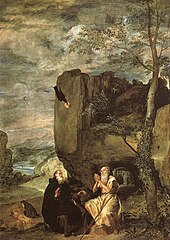Paul of Thebes

Paul of Thebes (* allegedly 228 ; † allegedly 341 ) is a Christian saint and, according to legend, the first Egyptian hermit and desert father , therefore also called Saint Paul the first hermit . His feast day is January 10th (Catholic) or January 15th (Orthodox). He is the patron saint of basket and mat weavers.
Life
The life story of Saint Paul of Thebes ( Amba Bola in Coptic ), which is nowhere else to be found, is handed down in the Vita Pauli primi eremitae written by Hieronymus around 376 (around 347–420) . According to this, Paul was allegedly born in Egypt in 228 as the son of wealthy Christian parents and, after the death of his parents and inheritance disputes with his brother during the persecution of Christians under Decius (249/50), he was the first Christian hermit and ascetic ( anchorite ) to go to the Egyptian desert . There he lived alone for decades, provided for by a spring, a palm tree and a raven that brought him half a loaf a day. When he was 113 years old, shortly before his death, he was visited by the then 90-year-old Antonius ( Antonius the Great , 251–356), who was revealed in a vision the existence of this neighboring elderly hermit who was on his way to the desert preceded. After a while, Paul is said to have sent Antonius away. He was supposed to get the cloak that Antony had received from Bishop Athanasios (around 300–373) to wrap the body of Paul in it. When he was back in Paul's cave, Paul is said to have already died. After Paul's death, Antony dug a grave for St. Paul with the help of two lions.
The actual, historical personality of Paul of Thebes is more than doubtful. It is assumed that Jerome with his story was more interested in highlighting his literary talent and providing the Vita Antonii of Athanasios with an alternative to the Christian legend of saints and surpassing it with the depiction of an older desert saint.
effect
In the fine arts, the meeting of the two original hermits is often represented, e.g. B. on a panel of the Isenheim Altarpiece by Matthias Grünewald in Colmar ( Musée d'Unterlinden ) or on a painting by Diego Velazquez in Madrid ( Museo del Prado ).
The attributes of Paul are crutch, palm, raven and two lions.
The Ordo Sancti Pauli Primi Eremitae (OSPPE), founded in Hungary in 1250 , chose Paul of Thebes as patron and role model.
Remembrance day
The Catholic feast day of the saint is January 10th.
Some followers of the peasant rules believe the following weather rules :
“If Paul’s Day is mild, there are rough winds in spring.
Sunshine at Paulus Einsiedel, brings a lot of grain and little wine. "
literature
- Hieronymus: Vita Pauli primi eremitae. German translation by Manfred Fuhrmann . In: Christians in the desert. Artemis, Zurich and Munich 1983.
- Stefan Rebenich: The church father Hieronymus as a hagiographer. The Vita Sancti Pauli primi eremitae. In: Kaspar Elm (Hrsg.): Contributions to the history of the Pauline order. Berlin 2000, pp. 23-40.
- St. Swidzinski: Saint Paul of Thebes. In: In the footsteps of St. Anthony. Commission Verlag Memminger Zeitung, 1994.
- Heinrich Holze: Paul of Thebes. In: Biographisch-Bibliographisches Kirchenlexikon (BBKL). Volume 7, Bautz, Herzberg 1994, ISBN 3-88309-048-4 , Sp. 89-92.
- Ernst Dassmann: Autobiography and Hagiography. On the self-portrayal of Hieronymus in his monastic lives, necrologists and letters of consolation. In: J. van Oort, D. Wyrwa (Ed.): Autobiography and hagiography in Christian antiquity. Leuven (B) 2009
Web links
Individual evidence
- ↑ Bazyli Degórski (ed.): Edizione critica della "Vita Sancti Pauli Primi Eremitae" di Girolamo , Institutum Patristicum "Augustinianum", Rome, 1987; Bazyli Degórski (Ed.): Hieronymi historica et hagiographica. Vita Beati Pauli monachi Thebaei. Vita Hilarionis. Vita Malchi monachi captivi. Epistula praefatoria in Chronicis Eusebii Caesariensis. Chronicorum Eusebii Caesariensis continuatio. De viris inlustribus. In Regulae S. Pachomii versionem praefatio (= Hieronymi opera, XV), Città Nuova, Roma 2014, pp. 73–115.
- ↑ Ludwig Schade: Hieronymus, Life of St. Paul, the first hermit. In: The Holy Church Father Eusebius Hieronymus selected writings translated from Latin, I (= Library of the Church Fathers). Kempten / Munich 1914, pp. 21–33., Accessed on July 22, 2016 .
- ^ Bernhard Kötting : Paulos v. Thebes . In: Josef Höfer , Karl Rahner (Ed.): Lexicon for Theology and Church . 2nd Edition. tape 8 . Herder, Freiburg im Breisgau 1963.
- ↑ Paulus von Thebes in the Ecumenical Lexicon of Saints
| personal data | |
|---|---|
| SURNAME | Paul of Thebes |
| BRIEF DESCRIPTION | Christian saint, first Egyptian hermit |
| DATE OF BIRTH | 228 |
| DATE OF DEATH | 341 |

